| dc.description.abstract | This master’s thesis asks a question regarding the possibility of including the theory ofself-efficacy in the Job Demands-Resources Model. To answer this, the connection betwe-en self-efficacy and motivation, job demands abd self-efficacy, and job resources and self-efficacy will be discussed. The study also questions the balance between job demands andjob resources in companies within the construction industry and what kind of influence thetwo aspects have on motivation. This study will be a theoretical contribution and can be usedto increase the well-being of the employees.This is a qualitative study, the researcher has a social constructivist point of view, and it isused both deductive and inductive strategy. Literature searches have been used to find rele-vant theory regarding job demands, job resources, self-efficacy and motivation. To answer thequestions in the study, four people from the construction industry (two from private and twofrom municipal enterprises) have been interviewed using a semi-structured interview.The results of this study show that self-efficacy clearly influences motivation. It appears thatgood self-efficacy can lead to good motivation, while poorer self-efficacy can lead to poorermotivation in the work. The findings also say that both job demands and job resources mayhave an impact on an employee’s self-efficacy. It turns out that some job demands affect bothself-efficacy and motivation, such as demanding emotional contact with customers, whileother job demands only affect motivation, just like noise. This also applies to job resources.An example of a job resource that affects both motivation and self-efficacy is support frommanagers or colleagues, while a job resource that only affects motivation is autonomy. In thisstudy it can be concluded that self-efficacy can be included in the Job Demands-Resourcesmodel, but that the job demands and job resources must be divided into two categories. Thethesis presents a model showing this. When it comes to the balance between job demandsand job resources in businesses within the construction industry, this varies greatly. Severalreasons for this are discussed through the study and it emerges how important this balanceis. It is pointed out that the results that appear in this study cannot be generalized to a largersample, but can be generalized analytically. | nb_NO |

